Winner Medals
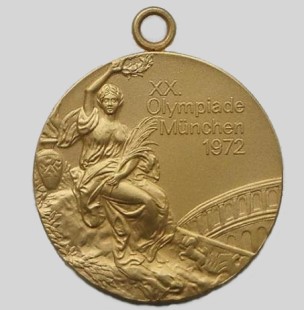

| 1st Place: | Gold Medal | Material: | Gilt Silver |
|---|---|---|---|
| Weight | 161 gr | ||
| 2nd Place: | Silver Medal | Material: | Silver |
| Weight | 150 gr | ||
| 3rd Place: | Bronze Medal | Material: | Bronze |
| Weight | 130 gr | ||
| Diameter: | 66 mm | Design by: | Gerhard Marcks |
| Mint: | Bavarian Mint | ||
| Thickness: | 4 mm | Ribbon: | Chain, 52 gr |
| Obverse: | Victory seated above stadium. | ||
| Reverse: | Romean twins Castor and Pollux, patrons of competitive sport and friendship, artist`s initial below. | ||
| Note: | The name of the winner and of sport discipline are engraved on the edge a few minutes after the competition.. | ||
| Numbers of Medals: | Gold: 364 Silver: 364 Bronze: 381 | ||
|
The Medals 1972
The IOC Statutes describe the prizes awarded. With respect to the size and weight of the medals, the IOC only specified minimum requirements. The OC exceeded the minimal diameter by 6 mm. and the thickness by 2 mm. The gold medal weighed 175 g., the silver one 169 g., and the bronze one 140 g. (But the real weight of the winner medals are 161 gr, 150 gr and 130 gr) 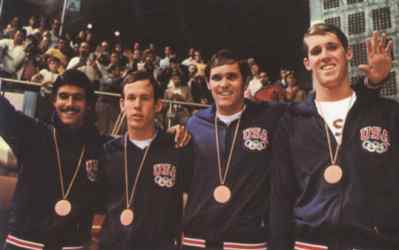 After the victorys ceremony: Mark Spitz, Jerry Heidenreich, David Edgar and John Murphy The OC needed 364 gold medals, 364 silver medals and 381 bronze medals, totaling 1,109 medals. In addition, it needed sufficient reserve medals for the unforeseeable event of multiple winners in the first three places. Three firms donated the material. The Bavarian Mint coined the medals gratis. Since 1928 the medals carried the same motif. In 1972 the goddess of victory was to grace the front of the medals together with the inscription "XX. Olympiade München 1972". Several artists submitted designs in a selective internal competition. The OC chose the design by Gerhard Marcks, one of the last surviving masters of Bauhaus. He chose Castor and Pollux, the patrons of competitive sports and friendship, as his motif and depicted them as naked youths. For the first time at Olympic Games chains replaced the usual ribbon which too easily became wrinkled and soiled. The chains were 90 cm. long, the links were made of 1.5 mm. thick brass material, and passed through a ring screwed onto the medal. According to the color of the medal, they were either bronze, silver or gold plated. The IOC approved the intended appearance of the medals in February, 1972 in Sapporo. 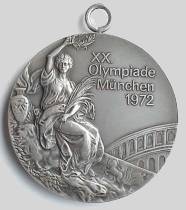 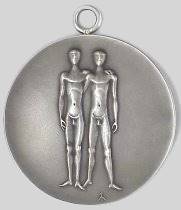
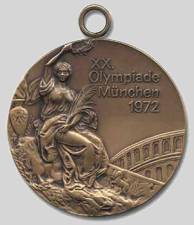
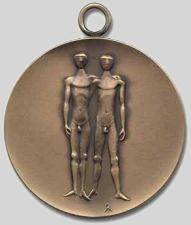 Producing the medals was complicated. The donor firms supplied the metal. The entire quantity of silver was formed into blanks in Switzerland. Later it was stamped in the main mint in Munich. The 364 silver medals were sent back to Switzerland for gold plating. The 730 brass chains, which were manufactured in the Federal Republic of Germany and had to be either gold or silver plated, were also sent to Switzerland. The OC had the names of the various sports and events engraved on all the medals in Munich. The winners received gold, silver or bronze lapel pins in addition to the medals. The IOC had not officially asked for them but it had become usual since the last Olympic Games. They were square and decorated with the Olympic emblem. (Source document: Official Report 1972, Vol. I., page 86) |
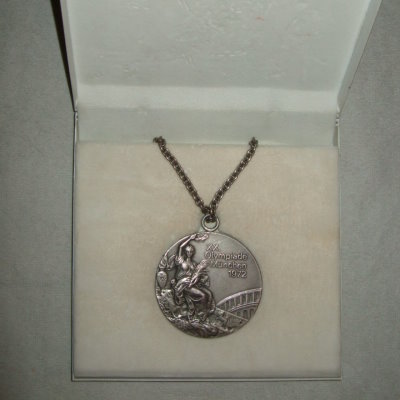
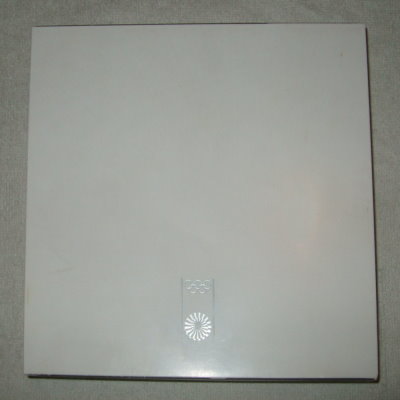


Images Copyright © Torsten Weick